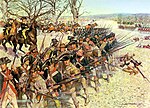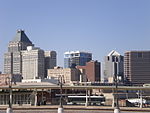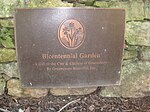Greensboro ( ; local pronunciation ) is a city in and the county seat of Guilford County, North Carolina, United States. It is the 3rd most populous city in North Carolina after Charlotte and Raleigh, the 69th-most populous city in the United States, and the most populous city in the Piedmont Triad metropolitan region. At the 2020 census, its population was 299,035; at the 2022 census estimate, its population was 301,115. Three major interstate highways (Interstate 40, Interstate 85, and Interstate 73) in the Piedmont region of central North Carolina were built to intersect at this city.
In 1808, Greensborough (the spelling before 1895) was planned around a central courthouse square to succeed Guilford Court House as the county seat. The county courts were thus placed closer to the county's geographical center, a location more easily reached at the time by the majority of the county's citizens, who traveled by horse or on foot.In 2003, the previous Greensboro–Winston-Salem–High Point Metropolitan Statistical Area was redefined by the U.S. Office of Management and Budget. The region was separated into the Greensboro-High Point Metropolitan Statistical Area and the Winston-Salem Metropolitan Statistical Area. The population of the Greensboro-High Point Metropolitan Statistical Area was 776,566 in 2020. The Greensboro–Winston-Salem–High Point Combined Statistical Area, commonly called the Piedmont Triad, had a population of 1,695,306 in 2020.Among Greensboro's many notable attractions, some of the most popular are the Greensboro Science Center, the International Civil Rights Museum, The Steven Tanger Center for the Performing Arts, the Weatherspoon Art Museum, the Greensboro Symphony, and the Greensboro Ballet. Annual events in the city include the North Carolina Folk Festival, First Fridays in Downtown Greensboro, Fun Fourth of July Festival, North Carolina Comedy Festival, and Winter Wonderlights. From 2015 to 2017, Greensboro hosted the National Folk Festival.The Greensboro Coliseum Complex hosts a variety of major sporting events, concerts, and other events. The main coliseum has been the site of the ACC men's basketball tournament 28 times (including the most recent tournament in 2023), more than twice the number hosted by any other site; it has hosted the ACC women's basketball tournament every year since 2000 (except for 2017). Since 2009, it has served as the home court for the UNCG Spartans NCAA Division I basketball team. The Novant Health Fieldhouse is home to the Greensboro Swarm of the NBA G League. In 2011, a major expansion of the complex added several new facilities, including the White Oak Amphitheatre, the Greensboro Aquatic Center, and the ACC Hall of Champions.
Local professional teams include the Greensboro Grasshoppers of the South Atlantic Baseball League, and the semi-professional Carolina Dynamo soccer club of USL League Two. Amateur teams include Greensboro Roller Derby and college teams in four NCAA programs. The Sedgefield Country Club features a Donald Ross course and is currently host to the annual PGA Tour event Wyndham Golf Championship. In 1953, representatives from seven member institutions of the Southern Conference met at the club and decided to withdraw from the Southern Conference to form a new league, the Atlantic Coast Conference. Greensboro would serve as Atlantic Coast Conference headquarters for 70 years, until the league relocated to Charlotte, North Carolina.







